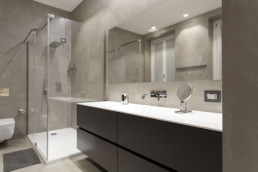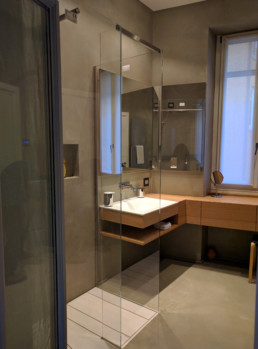
Private residence: Project by Roberto Bagnato Firm of Architects.
Resins are increasingly popular floor and wall coverings, especially in bathrooms where they replace tiles. Because they are waterproof they can also be used in showers. If resins are used it is very important to find a company that is expert in every phase of the laying process.
Resins come in different textures, from spatulate to striped, and in endless colours, depending on the manufacturer.
Resins are artificial compounds of epoxy or polyurethane (a plastic) and are subdivided into mono component and bicomponent.
The resin most suited to furnishing building interiors is water-based epoxy resin although solvent epoxy resins are also used. Polyurethane resin is more suited to outdoors use as it is more resistant.

Private residence: Project by Roberto Bagnato Firm of Architects.
Laying the resin
The peculiarity of resin is that it requires low thicknesses as total thickness is normally around 3-4mm. Before laying the resin the support must be carefully prepared so that it is smooth, dry and even. The first layer is laid with a fibreglass mesh to prepare the backing for the next layers so that they adhere and don’t crack. Two further layers are then laid on top followed by a finish coat and, finally, a transparent water-based protective film.
Given their nature resins must be laid properly and in a workmanlike fashion. Holes and imperfections that are not dealt with at once will be hard to repair once the resin has been laid. Resin differs from tiles because if damaged individual tiles can be replaced later.
Remember before laying
The beauty of this floor and wall covering derives from the seamless effect it achieves on floor and wall surfaces. If resin is laid on top of radiant panels a professional should be consulted as to how to conceal the join between the wall and floor to prevent the thermal expansion creating cracks and small fissures. If the join is visible a small 20 x 20 mm wainscot coated in the same resin as the wall and floor can be fitted.
Laying resin in wet rooms
Laying resin in wet rooms, eg. bathrooms, shower rooms, also requires particular care, especially around wall-mounted taps (rosettes should be removed), heated towel rail valves etc, so as not to leave any gaps. Indeed, if resin is not laid perfectly in these instances there could be problems with leaks and the formation of ugly water stains which might in due course damage the support.
